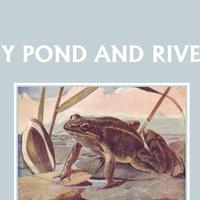CHAPTER 7. THE WATER-HEN AND THE COOT
IF your way to school lies along a river-path, where trees hang over the water, you will very likely have seen a water-hen and her little ones. Perhaps you may know where a nest is, either among the rushes, or on a bough of a tree over-hanging the water.
It is made of dead rushes, and though it is quite close to the water, it is dry and warm. If you are bathing you may look in. You will find about eight pale-grey eggs spotted with red-brown patches. Or perhaps some of the eggs may be hatched, and then the young birds will be hidden with their mother in the rushes. They are little black balls of fluff with red on their heads and white tail-feathers, and they can run and swim directly they are born. All the time you are looking, the mother, hidden in the rushes, will cry "Crr-ook, crr-ook" to drive you away. She is a black bird, about as big as a pigeon, with a bright red forehead and yellow beak. And she has white feathers on the edge of her wings and under her tail. When she is in the water, she keeps jerking her head down, so that you see the white feathers, and even her green legs with their red garters.
Very soon after the young water-hens are hatched, they slip out of the nest and swim round her. If you are lying very still among the bushes, you may perhaps see them all come out on to the bank, and feed on worms or snails. Then you can notice that their feet are not webbed like a duck's feet, but all four toes are separate. But if you make the least noise, the mother will cry "Krek-krek" to her little ones, and they will dive into the water and swim to a safe place among the rushes. They will not go back to the nest, and even if you beat the rushes with a stick they will not move. They know that they are safer in their hiding place.
This bird is often called a moor-hen and she goes to the moors sometimes. But Water-hen is her better name.
And now, if there is a large lake anywhere near, you will see the water-hen there, and another bird, which may think is the same, for she jerks her head and dives just in the same way. But if you look you will see that this second bird has not got a red forehead, but a large, bald patch on its head, and it is larger than the water-hen.
It is a bird called the coot, and often the "bald-headed coot," because of its bald patch. If you see one on the bank feeding on seeds or insects, you will notice that it has a wavy skin round each if its three front toes, though they are not joined together.
But the coot is not easy to see, for she is very shy. She runs up a tree, or dives under water, before you can get near her. She has sharp claws, which help her to climb, and which will hurt you if you catch her alive.
She builds her nest among the flags or rushes, almost touching the water. Sometimes her little ones are drowned when there is a flood.
If a boat comes near her nest, she slips off it into the rushes and cries "Kew-kew" to entice you away. If you find it, you will see about ten eggs in it. They are like the water-hen's eggs, but larger, and the spots are darker and smaller. If the eggs are hatched, you will you will know the little birds by their bald patch, though they are black, fluffy balls, just like those of the water-hen.
You will not find the coot in rivers; nor will you find her on the ponds in the winter. Then she starts off with a number of other coots to the sea in the south of England, and stays till spring comes again.

